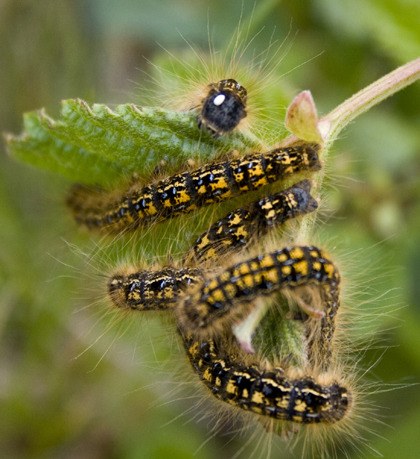Madrona Murphy has lived in the islands for 31 years and this year is the worst tent caterpillar outbreak she has ever seen.
“People keep asking us what to do about them,” said Murphy, a botanist at the Lopez-based laboratory Kwiaht.
More specifically, people want to know how to kill them.
The western tent caterpillar, with its orange and black markings, is an unpopular visitor. Periodic caterpillar outbreaks result in defoliation, minor branch dieback, and in some cases, tree mortality, according to the U.S. Fish and Wildlife Service.
The peaks or “outbreaks” are cyclical, tend to occur every six to 11 years and can last up to four years. These eruptions are generally regulated by weather and temperature.
“After an outbreak the population collapses and there are years in which the caterpillars are hard to find,” Murphy said.
This insect, which is four to five centimeters long, gets its name from the “tents” it spins on the tips of branches. Eggs hatch in early spring, and then larvae begin feeding. Young tent caterpillars usually eat all of the leaves on one branch before moving on to the next. They spin their cocoons in mid-June, and the adult moths emerge in seven to 10 days.
Murphy said this year some caterpillars hatched late and may keep eating until July.
“We don’t know if it is due to changes in the climate, but it looks like the tent caterpillar season may be longer this year than normal,” she added.
The good news is that caterpillars do not transmit diseases to humans and do not bite, according to Sharon J. Collman of Washington State University’s Extension Master Gardener Program in her article “Biology and Control of Tent Caterpillars.”
The bad news is a single tent may result in 20 percent defoliation of a small tree. Established trees can handle at least 25 percent defoliation without experiencing any ill effects, according to WSU gardener experts, but where trees are crowded or stressed, the leaf loss could be fatal.
Caterpillars may wreak havoc on weak trees, but these pests also have natural enemies – a highly contagious virus and a parasitic fly.
The virus passes easily from one caterpillar to the other so when the density of the caterpillars is high it leads to heavy mortality: imagine someone with meningitis in a mosh pit.
The other dangers these caterpillars face is even more insidious. If you see a caterpillar with one or more small white dots on its head those are the eggs of the tachinid fly.
“The larvae eat the caterpillars from the inside out,” said Murphy. “It’s pretty gruesome. And when these infected caterpillars pupate, the fly hatches and flies out instead of finishing its caterpillar meal.”
And there is one more animal that causes the destruction of this creepy crawler: humans, which have an assortment of weapons including fire and chemicals.
According to Whatcom County’s gardening extension website, you should never use fire as a control method for the pest as it can cause more damage to the tree.
“Don’t worry too much,” Murphy said. “Most trees will recover on their own this year, even if they look terrible right now.”
Murphy suggests picking caterpillars off small trees, but the best time to control the insect is next winter when you can remove the eggs before they hatch. Eggs, which are slightly bubbly gray crusts, are laid by the adult moths in late summer and are easily found in winter after trees drop their leaves and can be peeled off of the branches by hand.
Murphy said the next best option for controlling the caterpillars is after they hatch. When they are clustered around newly spun nests, she suggests cutting the insects out. Dispose of the affected branches by putting them in your compost, burning or immersing them in water or salt water.
“Once the caterpillars have dispersed throughout the tree, control becomes much more difficult,” she added.
Some sources recommend spraying the caterpillars with Bacillus thuringiensis, a bacterium that is toxic to caterpillars, but Murphy urges islanders to consider that Bt is a living organism and will continue to kill the caterpillars of other butterflies and moths.
“Patience may be the best course at this time since most caterpillars will stop eating in June and leave the trees to spin their cocoons,” said Murphy.
Despite the fact that tent caterpillars can do some pretty serious damage, they are not entirely destructive to the environment.
According to WSU gardener experts, some birds do feed on tent caterpillars and they can even be beneficial to trees.
“When alders and other trees are defoliated, the shrubs and trees below receive increased sunlight, giving some of them a boost in growth,” Collman said. “The eaten leaves pass through the caterpillar’s body and emerge as little pellets, which can break down easily, returning nutrients to the forest floor. Pupae provide nutritious meals for small mammals, and moths are eaten by birds and bats.”




